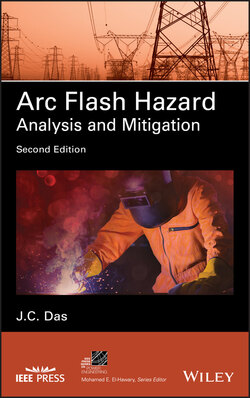Читать книгу Arc Flash Hazard Analysis and Mitigation - J. C. Das - Страница 44
1.15.1 Reduction
ОглавлениеThe protection system, coordination and suitable selection of additional protective devices can reduce the arcing times. Examples are differential protection, light sensing supervised by current signature, zone interlocking, arc flash maintenance switches which bring alternative relay settings into operation.
In some cases the arc fault current can be low resulting in increased fault clearing time. For example, the fault on the secondary side of a transformer, which is used by the transformer primary protection device. Due to ratio of transformation this current will be reduced resulting in prolonged clearing time. A secondary protective relay can be applied which will transfer trip primary proactive device.
Well-planned procedures, work practices and training can avoid arc flash hazards. Remote racking, remote control panels for switching, supervisory controls can help worker for safe operation from a distance outside the arc flash boundary. Infra-red windows, partial discharge sensors can be very helpful diagnostic tools.
Arc-resistant equipment can be used.
TABLE 1.14. Measures to Protect Against Arc Flash
| Mitigation | Type | Advantages | Disadvantages | Recommendations |
| Compartmentalization (IEC type-4b or ANSI equivalent barriers and boots | Prevention | Reduces the likelihood of arc flash by compartmentalization and insulating energized parts | Equivalent to a guard on a saw. Hazard is still present. Maintenance and testing may require exposure to energized parts | It does not reduce the energy available, it does reduce the probability of a fault. Compartmentalization or change incident energy calculation. |
| Arc-resistant equipment | Containment (passive) | Protects the worker by directing energy away from the worker when required covers are on. Tested per IEEE Std. C37.20.7 | Maintenance and testing may require removal of covers. Equipment is exposed to damage and has a larger footprint. May require second migration means to stay within rated arcing duration especially at LV | This measure offers protection for specific tasks, but does not reduce available energy. This measure is recommended where active mitigation methods are not acceptable. |
| High-speed shorting switch | Active (reduction) | Fights fire with fire. Re-directs arc flash energy into the bus by creating an intentional bolted fault; may use optical, differential and current waveform recognition. | Unconventional method and requires additional equipment. | May qualify as arc resistant per IEEE Std. 37.20.7. Needs robust controls to minimize chances of nuisance operation. |
| ZSI (blocking schemes) | Active (reduction) | Communication-aided transfer trip scheme that reduces breaker trip time and amount of energy released | Requires communication wiring between breakers. Trip units or relays must be installed with ZSI capability | Recommended for LV applications. Also available with some MV relays. |
TABLE 1.15. Matrix of Sample Arc Flash Mitigation Measures
| Technology | Arc-Flash Mitigation | Incremental Commissioning Complexity | Protection for Intentional Exposure | Protection for Incidental Exposure | Foot-print | Capital Expense | Operational Expenditure | Equipment Survivability | Arc Flash Incident Energy Reduction | Typical Application |
| Prevention | Barriers | Low | Limited | Limited | No change | Low | Low | Moderate impact | None | LV switchgear switchboard |
| ANSI compartmentalization | Low | Limited | Limited | No change | Low | Low | Moderate impact | None | LV switchgear switchboard | |
| IEC-4b compartmentalization | Low | Limited | Limited | No change | Low | Low | Moderate impact | None | LV switchgear switchboard | |
| HRG | High | Limited | Limited | Increased | Medium | Low | Moderate impact | SLG fault only | 480V to 5 kV | |
| Shielding barriers | Low | Limited | Limited | No change | Low | Low | No impact | None | LV arc-resistant switchgear | |
| Adm. controls | N/A | Limited | Limited | No change | Low | Low | No impact | None | All, training requirement | |
| Containment | Arc-resistant equipment | Low | No | Yes | Increased | High | Low | No impact | None | LV/MV switchgear |
| Solid dielectric bus | Medium | Yes | Yes | No change | Low | Low | Moderate | None | MV switchgear | |
| Reduction | Differential protraction | High | Yes | Yes | No change | High | Medium | impact | Significant | LV/MV switchgear |
| ZSI | Medium | Yes | Yes | No change | Low | Medium | Moderate | Significant | LV switchgear/ switchboard | |
| Transfer trip | High | Yes | Yes | Increased | High | Medium | impact | Significant | LV switchgear fed from transformers of >750 kVA |
TABLE 1.16. Measures for Mitigating Arc Flashes at Key Locations in Data Centers
| System Location | Issue | Recommendations |
| LV service entrance equipment | Protection on HV side of transformer does not respond quickly for LV faults | Transfer trip, differential protection along with ZSI |
| UPS input/output switchboards | Selectivity requirements lead to extended clearing times | ZSI or optical detection |
| PDU secondary (480 V to 208/120 V) | Low fault levels and P combined with transformer inrush currents extend arc-clearing times | Maintenance switch, compartmentalization of PDU with administrative controls |
| Generator paralleling equipment | Low fault levels combined with multiple sources extend arc-clearing times | Bus differential or optical detection, adaptive relay settings |
| MV distribution equipment | Multiple utility sources and/or generator sources result in high fault currents | High-speed shorting switch, bus differential, and optical relaying |
Figure 1.11. An outfit for PPE HRC4.
Figure 1.11 shows a PPE outfit for HRC=4. It looks like a space suit and hampers the mobility of a worker to render fine tasks. The arc flash energy must be reduced to no more than 8 cal/cm2 with appropriate measures.
